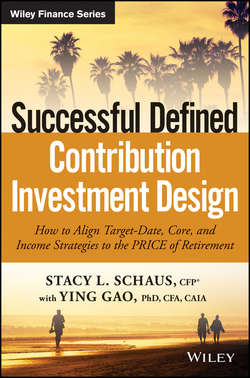Читать книгу Successful Defined Contribution Investment Design - Gao Ying - Страница 12
На сайте Литреса книга снята с продажи.
PART ONE
DC Plans: A Cornerstone of Retirement
CHAPTER 1
DC Plans Today: An Overview of the Issues
DC PLANS: BECOMING THE NEW REALITY.. NO TURNING BACK
ОглавлениеDC plans are a large and growing market globally, representing nearly half the world’s $36 trillion in estimated total pension assets. Over the past decade, the global share of pension assets held in DC plans in the world’s major pension markets has increased dramatically, from 39.9 percent in 2005 to 48.4 percent in 2015 – and DC assets have also grown at a faster pace than DB assets, at a rate of 7.1 percent per year compared to the slower pace of 3.4 percent per year for assets in DB plans (Willis Towers Watson, Global Pension Assets Study 2016, covering 19 major pension markets). While DC pension assets are increasing around the world, the United States, Australia, and the UK represent roughly 90 percent with 76 percent, 7.5 percent, and 6 percent of the global DC pension assets.
In 2014, we spoke to Brigitte Miksa, Head of International Pensions (and Executive Editor of PROJECT M at Allianz Asset Management AG), about the development of retirement systems around the globe. We discussed the shift in weight among the pillars or sources of retirement income, including the first source of public pensions, such as Social Security, and the second source of occupational programs, both DB and DC. We also contrasted reliance on the different sources of retirement income and DC developments within three market segments: Anglo-Saxon countries, developed European countries, and emerging pension markets.
Looking forward, as each market develops and DC assets grow, Miksa expects the plans in these markets will become increasingly “professionalized,” such that decision-making about asset allocation and more will shift over time to professionals, away from individual participants. (These shifts mirror the evolution toward institutionalized structures for DC plans discussed above.) She told us:
Starting in the early 1990s, many countries initiated pension reforms and we began to see shifts in the dependency on different retirement income pillars. The initial wave of reforms focused on sustainability of the first pillar – government-funded public pensions such as Social Security. With the recent financial crisis, more pressure has been placed on reforming public pensions, and fortunately, these efforts have been quite successful in many cases. For instance, increasing the age for public pension qualification will help with the sustainability of public pensions in many countries.
Another significant global shift is occurring in the second pillar – employer-sponsored or occupational pension schemes. We continue to see rapid movement away from defined benefit pension plans and toward defined contribution systems. This shift started in the Anglo-Saxon countries, including the U.S., Australia, Canada and the U.K., and continues to spread to other developed markets like the Netherlands and Norway, as well as to the emerging markets.
Over the past decade, Miksa told us, more than half of the 34 countries in the Organisation for Economic Co-operation and Development (OECD) have rolled out DC programs. While the Anglo-Saxon countries continue to dominate in their percentage of global DC assets accumulated, other markets are showing rapid development; these include Denmark, Israel, Italy, and Turkey.
As the move away from traditional DB pension plans continues, workers are increasingly reliant on DC pension schemes to build their own retirement income. Employers, too, are reliant on DC plans to both attract and retain talent, and to manage their workforce – reducing the cost and the potentially detrimental effect of retaining workers beyond their desired retirement age. Multinational corporations commonly manage their DC plans worldwide with the aim of providing a valuable retirement savings vehicle as well as local-market competitive benefits (PIMCO’s 2015 Global DC Survey for Multinational Corporations). Over a third of these organizations have a written global retirement plan philosophy, while another third say they are likely to write one over the next year or two. These employers view “the ability to attract and retain talent” as the top return on investment for offering retirement benefits – this motivation is followed by a “sense of doing what’s right.”
